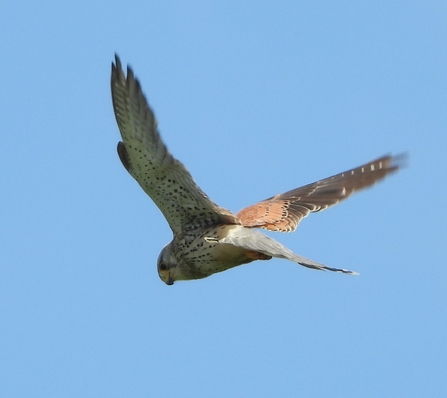Neville Davies
A Little Grebe
Lowri Watkins
Neville Davies
A Little Grebe
The weather on both walks was ideal and within the two weeks you could really see how wildlife was changing. April 2nd saw a good turnout of people, and in all 38 species of bird were seen with the highlights being not one, not two, but three Sparrowhawks circling over the woods. As I was explaining about the association of Mistletoe with the Mistle Thrush, as if on cue, one flew into the Poplar tree to complete the scene. As usual, the Cettis Warbler called close by but remained elusive, but several Chiffchaffs and Blackcaps were more obliging.
There seemed to be a lot of activity from birds establishing territories and singing their little hearts out, and at the hide, two pairs of Grey Herons were seen nesting in the tall trees at the back of the pond, with Little Grebe, Coot, Teal and a Gadwall putting on a show. The group particularly liked seeing Scarlet Elf Cap fungi in the damp copse near the hide, and liked the explanation of the name deriving from pixies drinking the morning dew from the cups. Pockets of Marsh Marigold were coming into flower and Hart's Tongue Ferns were 'unfurling' their long fronds. The circular walk ended with a good mix of flora and fauna having been seen, and people getting to know each other better along the way which was nice.
Neville Davies
Scarlet Elf Cap
April 16th saw the return visit, this time for new members to see Magor Marsh and learn about the wildlife from myself, and the local history from GWT stalwarts Julia and Roger James.
A good number of bird species were seen again, with singing Sedge Warblers and Willow Warblers now being added to the list. Things were different from the hide too, with three pairs of Grey Herons nesting, accompanied by an amazing scene of 41 Little Egrets in the tall trees. The group loved this moment, listening to their strange almost prehistoric like calls, and seeing the fine plumes on the heads of the males.
The Scarlet Elf Caps were still in evidence along with some Turkey Tail fungus (so called as the brackets look like the tail of a turkey), and a single Jelly Fungus was also seen.

Neville Davies
A Kestrel
The meadow had a good scattering of Lady Smock in flower, and coincidentally we saw the first Orange Tip butterflies of the season which rely on this plant to lay their eggs. We observed the work of a Leaf Miner Beetle with an explanation by Roger, and a Mallard egg shell was also found on the path. A Kestrel obligingly sat on the edge of the Willow copse affording lovely close views before flying off. Small White butterflies were in abundance and a Skylark was singing over the meadow with a male Pheasant nestled against the hedge. The birds were so much more active this time, criss-crossing the reserve, some like the Starlings carrying food, others like the Rooks and Jackdaws carrying twigs for their nests.
Overall, the two walks were well attended with a great mix of lovely people. My thanks to Hamish, Julia and Roger for their support and to the participants on the day. I look forward to meeting you all again soon.
Neville Davies, GWT member, author, and nature expert. @ecology_cymru wildmajorca@gmail.com Pictures copyright Neville Davies.
Neville Davies
A female Orange tip butterfly on Ladysmock